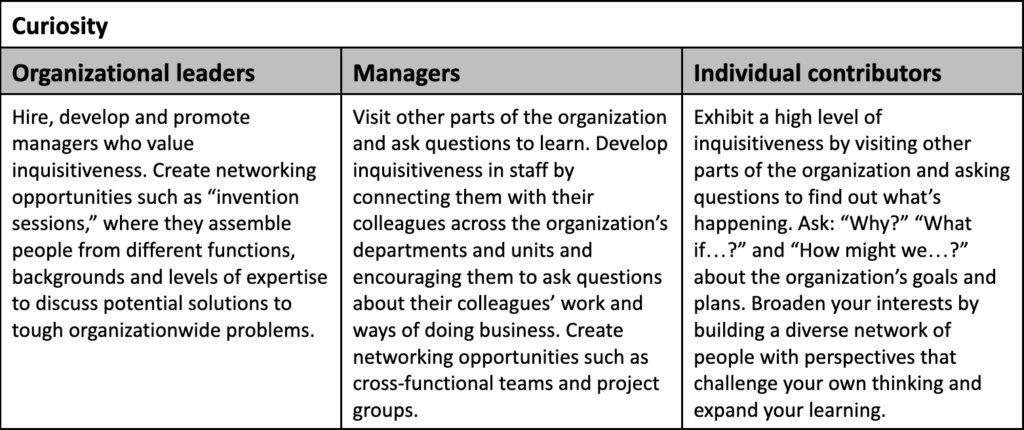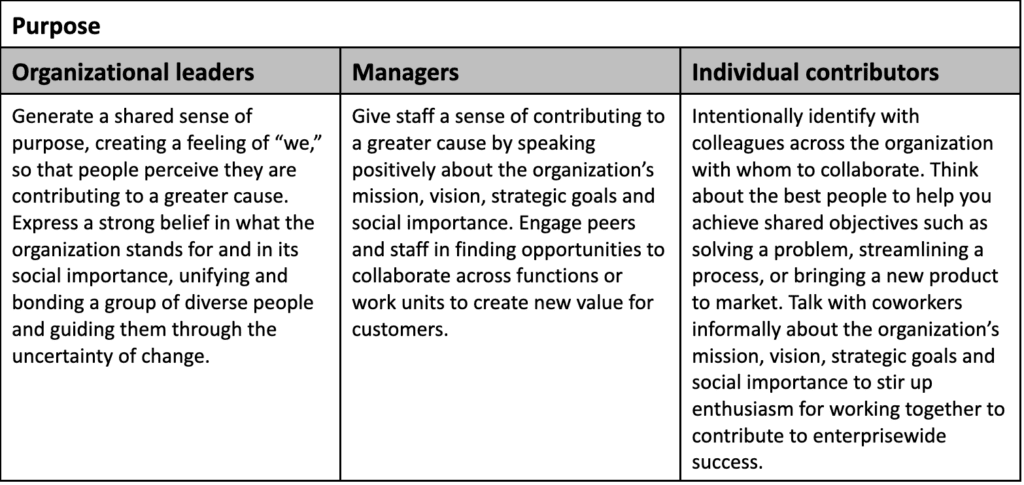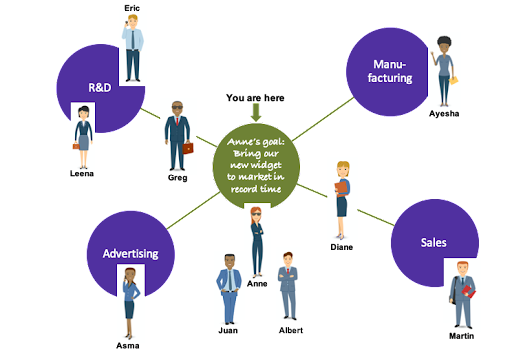In many organizations, there are structural barriers that keep people siloed from one another. Employees isolated in roles, functional areas and hierarchical tiers can lack a sense of belonging and inclusion. They don’t know the “who, what, why and how” of the organization, much less how they fit into it.
As we’ll explore in this article, you, as a leader in learning and development, can break down these barriers. It’s a matter of curiosity, connection and purpose.
It takes effort, but the payoff is huge
Research published in “Personnel Psychology” has shown that internal networking increases employees’ desire to stay with an organization, reducing the likelihood of costly turnover by 140 percent.
The research further indicates that retention is closely linked to the extent to which people feel attached, or feel they belong, to the organization that employs them. Internal networking that isn’t bound by functional silos or hierarchy — what we call “silo-busting networking” — creates organizations people are happy to be a part of.
Silo-busting networking, even in traditional hierarchies, encourages cross-company collaboration and a continual exchange of resources between and among employees. These resources include information, services and influence that help people achieve their goals and get work done.
The “Personnel Psychology” study points out: “the exchange of interpersonal resources via networking helps employees develop greater comfort with work-related tasks and their social environments, which increases perceptions of ‘fit’ within the organization.”
Perhaps most importantly, the interpersonal nature of the interactions provides fertile ground for friendships and other emotional support, generating a strong sense of belonging. Severing these ties by leaving the organization represents an emotional sacrifice. In this way, silo-busting networking is a powerful tool to attract and retain diverse, high-performing, high-potential talent.
It starts with the right culture: curious, connected, purposeful
As with all things related to the way work gets done in an organization, internal networking or a lack thereof is part of the organization’s culture. People will collaborate across functions, locations or business units only when such behavior is supported by the culture.
In a typical hierarchical culture, there is a power struggle among silos. People are competing for knowledge, dollars, talent and recognition for achievement because all of these are sources of power. Most typically stay within their silos. And while they may feel a sense of belonging to their team, they often don’t know what’s happening in other parts of the organization and don’t see themselves as part of a greater whole.
In a silo-busting networking culture, collaboration replaces competition and the power dynamic breaks down. People are curious about what is going on in other parts of the organization and feel free to ask questions about the organization’s goals and plans. They are connected to colleagues throughout the organization through a network of relationships. And they share a common purpose: supporting enterprisewide success.
Culture starts at the top
Organizational behaviorist Larry Senn said, “Culture is the shadow of the leader.” The executives of the organization set the group norm through their words, but more importantly through their behaviors. Employees will emulate a leader’s behaviors because they want to fit in and be successful. They see leaders’ behaviors as the formula for success.
In a silo-busting networking organization, leaders create a culture of cross-company collaboration. They set an example by working across the organization, shifting from a focus on the success of their particular function or business unit to ownership over the success of the entire enterprise.
Who is responsible for silo-busting networking? Everyone
The organization’s leaders use silo-busting networking behaviors to create a supportive culture. Managers model leaders’ behaviors and champion the culture. And individual contributors use silo-busting networking behaviors to create internal networks. Figures 1 through 3 provide an overview of silo-busting networking behaviors at three organizational levels: leader, a person who heads up a major function or business unit; manager, someone below the leader level who has people reporting to them; and individual contributor. Figure 1 shows curiosity behaviors. Figure 2 shows connected behaviors. And Figure 3 presents purpose behaviors.



What can L&D do to make silo-busting networking part of the culture?
As an L&D professional, you can be a catalyst for creating a culture of silo-busting networking. You can facilitate the development of extensive intraorganizational networking opportunities such as online communities, mentoring programs, job rotations and enterprisewide networking events.
More importantly, you can drive the adoption of silo-busting networking by providing learning and skill development opportunities. Starting with the organization’s leaders and working your way through the rest of the organization, you can help people understand the benefits of cross-company collaboration and facilitate the development of the silo-busting networking skills: curiosity, connection and purpose.
You can help people develop curiosity, connection and purpose by conducting a series of instructor-led skill-building workshops presented in-person, online, blended or in a hybrid format. The workshops should, of course, be interactive, and can be reinforced through e-learning and on-the-job activities.
While it’s important for people to learn all three silo-busting networking skills, perhaps the most important is purpose. Networking with purpose means networking with intention. Intention is a focus on desired end results — at the enterprise, work unit and individual level — and networking with specific people who can help propel all of them toward those results.
Networking merely for the sake of networking takes up precious time and often doesn’t yield useful results. But networking on the job, as a part of how things get done, has enormous value to individuals and the organization. It is purpose, or intentionality, that makes networking and collaboration pay off.
Employees need tools to aid them in networking purposefully. Here are three of the tools for silo-busting networking that people can learn in a workshop and put to use on the job:
- Power-mapping is a visual strategy for creating a network of relationships with groups or individuals aimed at accomplishing a specific work result.
- Strategic connections are relationships with key people in the company to enhance your visibility and to help others connect with one another, thereby strengthening the collaborative fabric of the organization.
- Influence plans for a particular initiative or objective include a list of key people whose support is needed, what and how you’ll communicate in order to influence them, their potential reactions, and your responses to those reactions.
All three tools will make employees’ on-the-job networking purposeful and generate real value. But power-mapping is the most effective for building strong relationships that yield superior results. It’s a tool for determining the people who can provide the information, services, influence and other resources required to get something done.
How does power-mapping work?
Power-mapping originated with individuals engaged in promoting positive social change. It helps people think about context, hierarchies and relationships within work spheres, so it adapts well to the business environment.
The objective is to map a network in a particular context with a single objective in mind. This could be a one-off, e.g., successfully executing a project or solving a problem. Or it could be ongoing, such as increasing efficiency or in some other way improving performance. Either way, it requires a goal that focuses on the desired results, or the intent. Depending on the complexity of the goal, it may also require a list of steps before mapping begins.
There are three steps to creating a power map.
- Write a goal statement that specifies the result to be achieved (the intent) and the timeframe. The goal statement must be clear in order to communicate effectively with others about it.
- Identify the people whose cooperation/involvement is needed, what each one must do, and the easiest ways to access and influence these people, either directly or indirectly through someone else.
- Plot all these people and the influence paths on a power map and develop a plan for reaching and influencing these people.
Figure 4 is an example of a power map. The map belongs to Anne, vice president of marketing. Her purpose in developing the map is to achieve the goal of bringing a new widget to market in record time.

Anne has spent time getting to know people, visiting their offices and displaying genuine curiosity about them personally and about their departments. In this way, she’s built solid connections with many people.
She’s identified everyone whose support she needs to achieve her goal. More importantly, she has an influence plan that involves going directly to some people, like Ayesha in manufacturing and Asma in advertising. But her plan also includes leveraging her relationships with Greg the COO and Diane the vice president of sales to help her make her case to Leena in R&D and Martin in sales. Her plan is based on the nature of the connections she’s made in the organization and what she’s learned about people she’s connected with.
You may need to start small
If you’re unsure if your organization is ready for silo-busting networking, give it a try in one department or business unit that has been an early adopter of innovation. Get the leader’s buy-in and make sure they understand their part as the role model. Then, conduct a few silo-busting networking workshops, and introduce managers and individual contributors to the benefits and skills of effective networking. Teach them to use power mapping, check in with them on progress and coach them if they run into obstacles.
If silo-busting networking is successful in one area, the word will get out and others will want to jump on the bandwagon. With luck, you’ll reach a tipping point where silo-busting networking becomes part of the culture and your organization reaps the benefits.
A silo-busting networking case study:
WL Gore, winner of numerous good-places-to-work awards, is an example of a company to which people, in general, feel attached. Although they don’t call it this, silo-busting networking is at the core of this “stickiness.”
Gore has a “lattice” structure with permeable boundaries created by cross-functional, cross-team communication. The structure is based on connection among associates where direct communication is seen as critical to success. If an associate needs another associate’s input, they don’t need to ask the other associate’s leader. They can contact that associate directly.
Gore has no traditional hierarchy. Within the company’s lattice structure, various activities have leaders who are selected based on their merits and their ability to attract followers. Although we don’t know what Gore leaders do to attract followers, we do know that people will follow only those leaders they trust. Leaders build trust through asking questions to learn, building and maintaining relationships and engaging in cross-functional collaboration, all silo-busting networking skills.
While Gore’s structure is not without its challenges, the case demonstrates that internal networking encourages communication and innovation.















